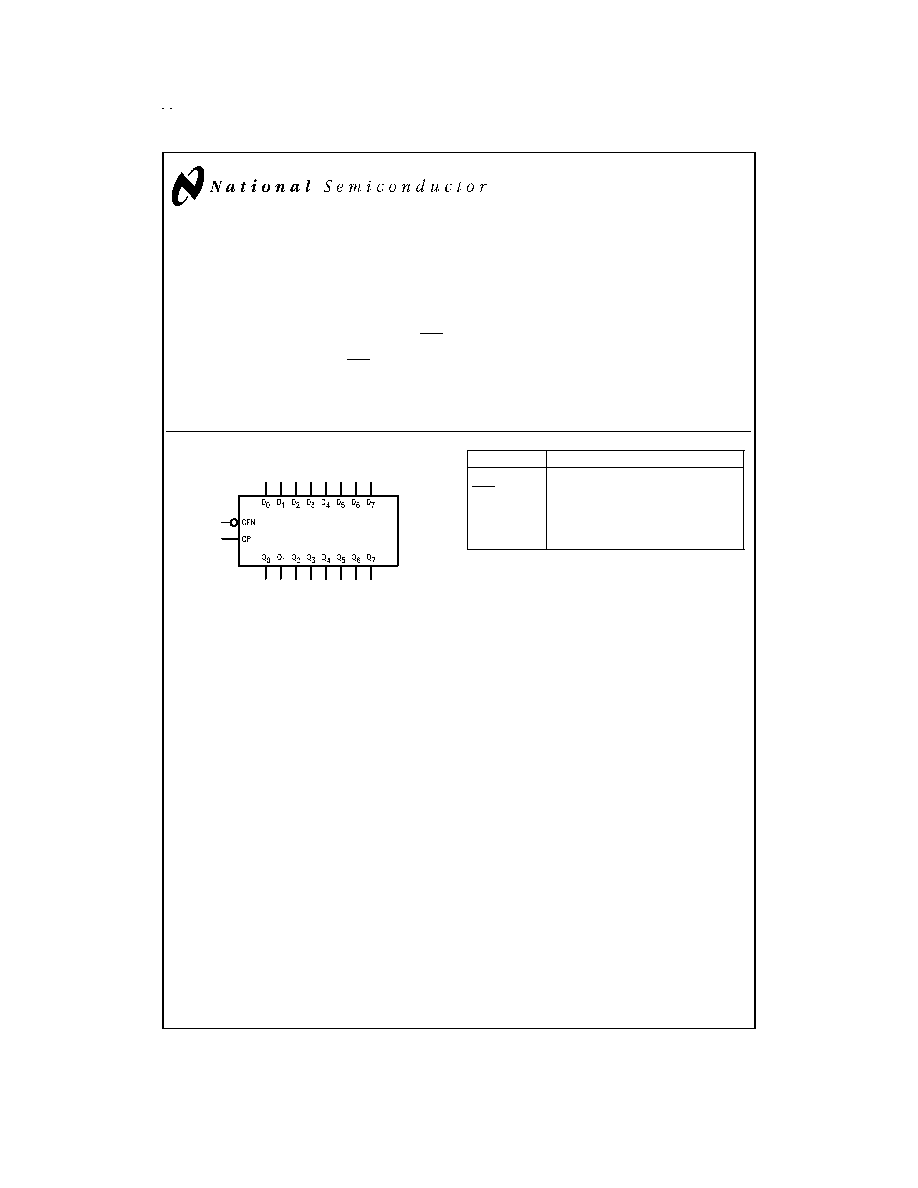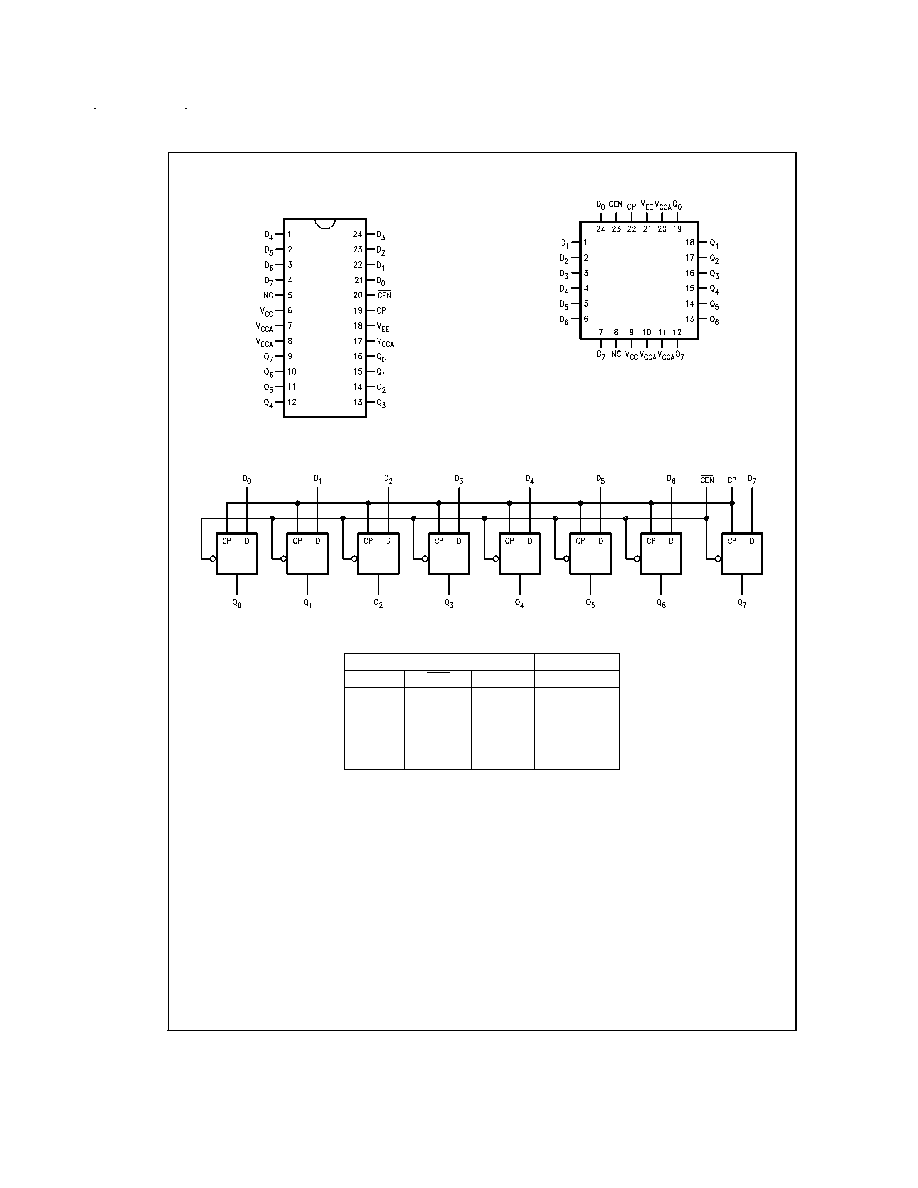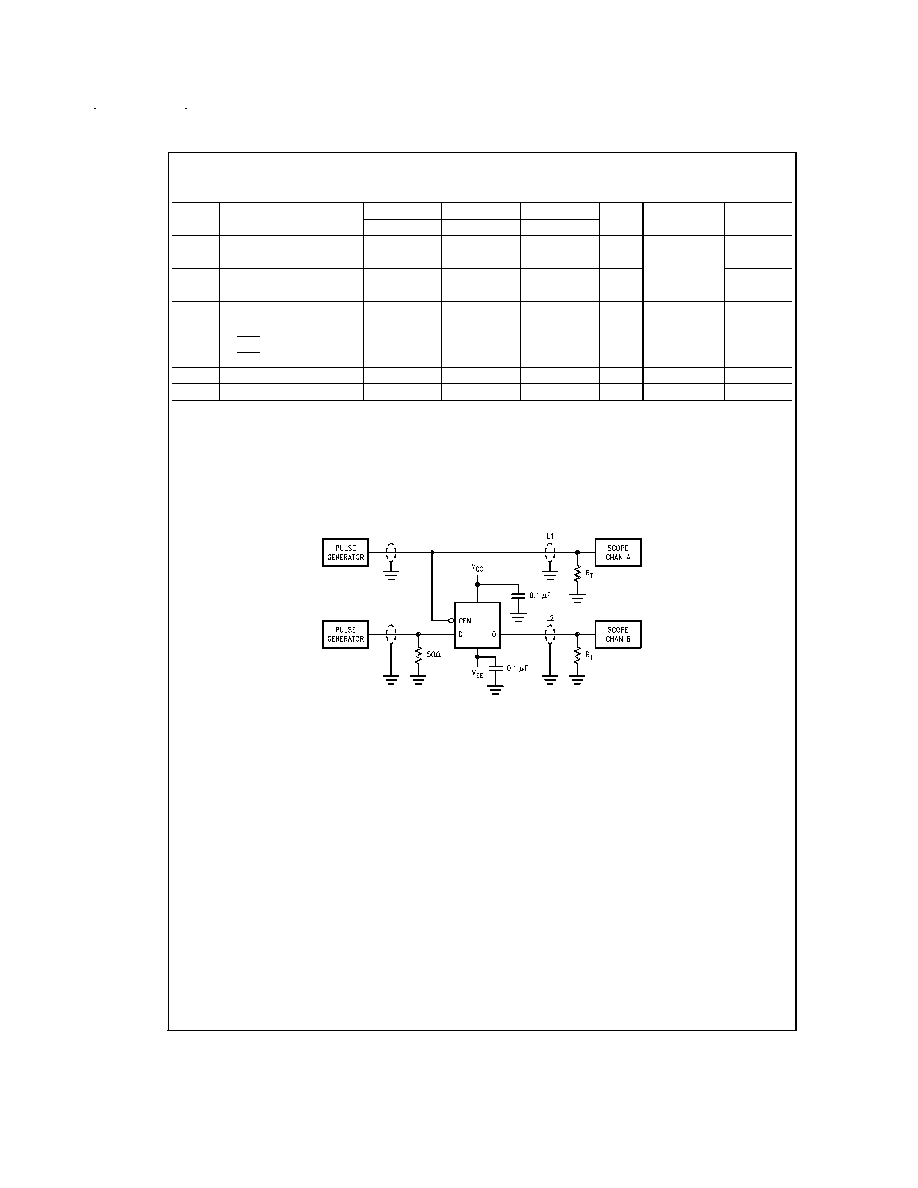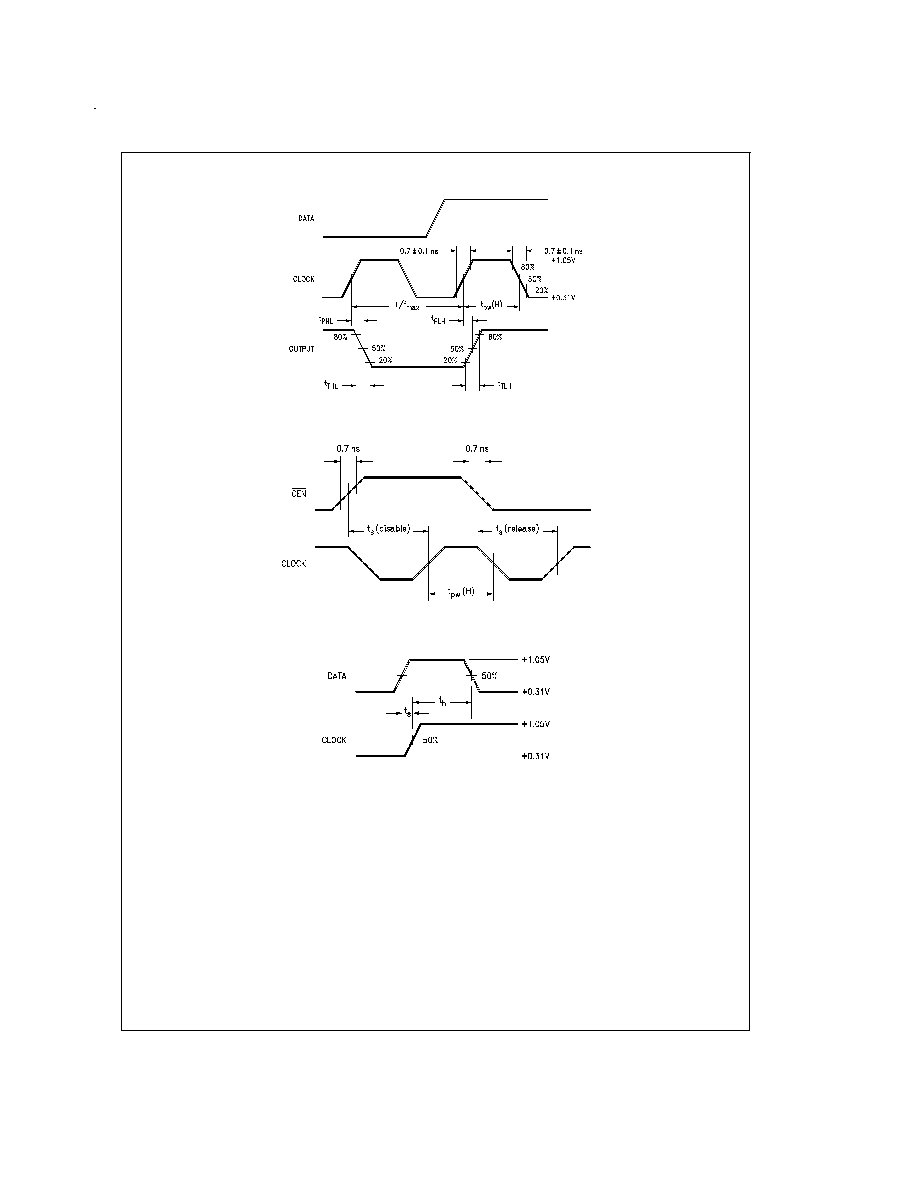 | –≠–ª–µ–∫—Ç—Ä–æ–Ω–Ω—ã–π –∫–æ–º–ø–æ–Ω–µ–Ω—Ç: 100353QCX | –°–∫–∞—á–∞—Ç—å:  PDF PDF  ZIP ZIP |

100353
Low Power 8-Bit Register
General Description
The 100353 contains eight D-type edge triggered, master/
slave flip-flops with individual inputs (D
n
), true outputs (Q
n
),
a clock input (CP), and a common clock enable pin (CEN).
Data enters the master when CP is LOW and transfers to the
slave when CP goes HIGH. When the CEN input goes HIGH
it overrides all other inputs, disables the clock, and the Q out-
puts maintain the last state.
The 100353 output drivers are designed to drive 50
termi-
nation to -2.0V. All inputs have 50 k
pull-down resistors.
Features
n
Low power operation
n
2000V ESD protection
n
Voltage compensated operating range = -4.2V to -5.7V
n
Available to MIL-STD-883
Logic Symbol
Pin Names
Description
D
0
≠D
7
Data Inputs
CEN
Clock Enable Input
CP
Clock Input (Active Rising Edge)
Q
0
≠Q
7
Data Outputs
NC
No Connect
DS100316-4
August 1998
100353
Low
Power
8-Bit
Register
© 1998 National Semiconductor Corporation
DS100316
www.national.com

Connection Diagrams
Logic Diagram
Truth Table
Inputs
Outputs
D
n
CEN
CP
Q
n
L
L
N
L
H
L
N
H
X
X
L
NC
X
X
H
NC
X
H
X
NC
H = HIGH Voltage Level
L = LOW Voltage Level
X = Don't Care
NC = No Change
N
= LOW to HIGH Transition
24-Pin DIP
DS100316-1
24-Pin Quad Cerpak
DS100316-2
DS100316-5
www.national.com
2

Absolute Maximum Ratings
(Note 1)
If Military/Aerospace specified devices are required,
please contact the National Semiconductor Sales Office/
Distributors for availability and specifications.
Above which the useful life may be impared
Storage Temperature (T
STG
)
-65∞C to +150∞C
Maximum Junction Temperature (T
J
)
Ceramic
+175∞C
V
EE
Pin Potential to Ground Pin
-7.0V to +0.5V
Input Voltage (DC)
V
EE
to + 0.5V
Output Current (DC Output HIGH)
-50 mA
ESD (Note 2)
2000V
Recommended Operating
Conditions
Case Temperature (T
C
)
Military
-55∞C to +125∞C
Supply Voltage (V
EE
)
-5.7V to -4.2V
Note 1: Absolute maximum ratings are those values beyond which the de-
vice may be damaged or have its useful life impaired. Functional operation
under these conditions is not implied.
Note 2: ESD testing conforms to MIL-STD-883, Method 3015.
Military Version
DC Electrical Characteristics
V
EE
= -4.2V to -5.7V, V
CC
= V
CCA
= GND, T
C
= -55∞C to +125∞C
Symbol
Parameter
Min
Max
Units
T
C
Conditions
Notes
V
OH
Output HIGH Voltage
-1025
-870
mV
0∞C to
+125∞C
-1085
-870
mV
-55∞C
V
IN
= V
IH
(Max)
Loading with
(Notes 3, 4, 5)
V
OL
Output LOW Voltage
-1830 -1620
mV
0∞C to
or V
IL
(Min)
50
to -2.0V
+125∞C
-1830 -1555
mV
-55∞C
V
OHC
Output HIGH Voltage
-1035
mV
0∞C to
+125∞C
-1085
mV
-55∞C
V
IN
= V
IH
(Min)
Loading with
(Notes 3, 4, 5)
V
OLC
Output LOW Voltage
-1610
mV
0∞C to
or V
IL
(Max)
50
to -2.0V
+125∞C
-1555
mV
-55∞C
V
IH
Input HIGH Voltage
-1165
-870
mV
-55∞C to
Guaranteed HIGH Signal for all Inputs
(Notes 3, 4, 5, 6)
+125∞C
V
IL
Input LOW Voltage
-1830 -1475
mV
-55∞C to
Guaranteed LOW Signal for all Inputs
(Notes 3, 4, 5, 6)
+125∞C
I
IL
Input LOW Current
0.50
µA
-55∞C to
V
EE
= -4.2V
(Notes 3, 4, 5)
+125∞C
V
IN
= V
IL
(Min)
I
IH
Input HIGH Current
240
µA
0∞C to
V
EE
= -5.7V
V
IN
= V
IH
(Max)
(Notes 3, 4, 5)
+125∞C
340
µA
-55∞C
I
EE
Power Supply Current
-55∞C to
Inputs Open
-132
-42
mA
+125∞C
V
EE
= -4.2V to -5.7V
(Notes 3, 4, 5)
Note 3: F100K 300 Series cold temperature testing is performed by temperature soaking (to guarantee junction temperature equals -55∞C), then testing immediately
without allowing for the junction temperature to stabilize due to heat dissipation after power-up. This provides "cold start" specs which can be considered a worst case
condition at cold temperatures.
Note 4: Screen tested 100% on each device at -55∞C, +25∞C, and +125∞C, Subgroups 1, 2, 3, 7, and 8.
Note 5: Sample tested (Method 5005, Table I) on each manufactured lot at -55∞C, +25∞C, and +125∞C, Subgroups A1, 2, 3, 7, and 8.
Note 6: Guaranteed by applying specified input condition and testing V
OH
/V
OL
.
AC Electrical Characteristics
V
EE
= -4.2V to -5.7V, V
CC
= V
CCA
= GND
Symbol
Parameter
T
C
= -55∞C
T
C
= +25∞C
T
C
= +125∞C
Units
Conditions
Notes
Min
Max
Min
Max
Min
Max
f
max
Toggle Frequency
400
400
400
MHz
Figures 1, 2
(Note 10)
www.national.com
3

AC Electrical Characteristics
(Continued)
V
EE
= -4.2V to -5.7V, V
CC
= V
CCA
= GND
Symbol
Parameter
T
C
= -55∞C
T
C
= +25∞C
T
C
= +125∞C
Units
Conditions
Notes
Min
Max
Min
Max
Min
Max
t
PLH
Propagation Delay
0.70
3.30
0.80
3.10
0.80
3.50
ns
(Notes 7, 8,
9, 11)
t
PHL
CP to Output
Figures 1, 2
t
TLH
Transition Time
0.40
2.20
0.40
2.20
0.40
2.20
ns
(Note 10)
t
THL
20% to 80%, 80% to 20%
t
s
Setup Time
D
n
0.30
0.30
0.30
CEN (Disable Time)
0.60
0.60
0.60
ns
Figures 1, 3
(Note 10)
CEN (Release Time)
1.40
1.40
1.40
t
h
Hold Time
D
n
1.50
1.50
1.50
ns
Figures 1, 4
(Note 10)
t
pw
(H)
Pulse Width HIGH
CP
2.00
2.00
2.00
ns
Figures 1, 2
(Note 10)
Note 7: F100K 300 Series cold temperature testing is performed by temperature soaking (to guarantee junction temperature equals -55∞C), then testing immediately
after power-up. This provides "cold start" specs which can be considered a worst case condition at cold temperatures.
Note 8: Screen tested 100% on each device at +25∞C temperature only, Subgroup A9.
Note 9: Sample tested (Method 5005, Table I) on each manufactured lot at +25∞C, Subgroup A9, and at +125∞C and -55∞C, temperatures, Subgroups A10 and A11.
Note 10: Not tested at +25∞C, +125∞C, and -55∞C temperature (design characterization data).
Note 11: The propagation delay specified is for single output switching. Delays may vary up to 300 ps with multiple outputs switching.
Test Circuitry
DS100316-6
Notes:
V
CC
, V
CCA
= +2V, V
EE
= -2.5V
L1 and L2 = equal length 50
impedance linesR
T
= 50
terminator internal to scopeDecoupling 0.1 µF from GND to V
CC
and V
EE
All unused outputs are
loaded with 50
to GNDC
L
= Fixture and stray capacitance
3 pF
FIGURE 1. AC, Toggle Frequency Test Circuit
www.national.com
4

Switching Waveforms
DS100316-8
FIGURE 2. Propagation Delay (Clock) and Transition Times
DS100316-9
FIGURE 3. Setup and Pulse Width Times
DS100316-10
Note 12: t
s
is the minimum time before the transition of the clock that information must be present at the data input.
Note 13: t
h
is the minimum time after the transition of the clock that information must remain unchanged at the data input.
FIGURE 4. Data Setup and Hold Time
www.national.com
5




